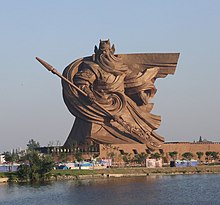Statue of Guan Yu (Jingzhou)
关公义园 | |
 | |
 | |
| 30°20′31″N 112°12′28″E / 30.34194°N 112.20778°E | |
| Location | Jingzhou, Hubei, People's Republic of China |
|---|---|
| Designer | Han Meilin |
| Material | Steel framing, reinforced by concrete, bronze strips |
| Height | 58 metres (190 ft) |
| Weight | 1197 tonnes |
| Visitors | 220,000 (in 2018) |
| Beginning date | 2013 |
| Completion date | 17 June 2016 |
| Dedicated to | Guan Yu |
The Guan Yu Statue was a large monument to Chinese deified military general Guan Yu that was formerly located in Jingzhou, China. The statue was designed by Han Meilin, and finished construction in 2016.[1] It stands at 58 metres tall, weighs 1,197 tonnes, and is made of around 4,000 bronze strips.[2] The project began in 2013 when Han Meilin visited Jingzhou for inspiration, and personally oversaw the designing and installing of the statue.
Guan Yu was depicted wearing his traditional robes and cloak, whilst wielding his famous guandao known as the Green Dragon Crescent Blade,[3] which weighs 123 tonnes.[4] The figure stood atop a 10 metre pedestal, which resembles an ancient Chinese warship.[5] Inside the base is a 7,710 square-metre museum and shrine to Guan Yu.[5]
The project cost 1.5 billion yuan,[6] and was officially opened to the public on June 17, 2016. On the day of the unveiling, activities such as worship, visiting fairs, and praying to Guan Yu were held. Han Meilin was present for the ceremony.[4]
Background[edit]
Guan Yu was a Chinese military general serving under the warlord Liu Bei during the late Eastern Han dynasty. His life was lionised and his achievements glorified to such an extent after his death in 220 that he was deified during the Sui dynasty. Through generations of story telling, culminating in the 14th-century historical novel Romance of the Three Kingdoms, his deeds and moral qualities have been given immense emphasis, making Guan Yu one of East Asia's most popular paradigms of loyalty and righteousness. He is still worshipped today as a bodhisattva in Buddhist tradition and as a guardian deity in Chinese folk religion and Taoism. He is also held in high esteem in Confucianism.
Relocation[edit]
In September 2020, the Ministry of Housing and Urban-Rural Development criticized the Guan Yu statue as "vain and wasteful", and that its towering presence in the skyline "ruined the character and culture of Jingzhou as a historic city" and called for rectification.[6] An investigation by the state broadcaster China Central Television revealed that the project's developers only had permission to build the pedestal of the statue (the museum). The developers, treating the statue as a piece of art, claimed to be unaware that large statues required their own planning processes, nor were they aware that the statue's current location had a height limit of 15m.[7] Additionally, land under the statue started to sink under its weight.
In response to the central government order, Jingzhou city officials announced in October that the statue will be relocated.[7] The new location of the statue will be 8 km away in Dianjiangtai, where Guan Yu was said to have drilled his troops. The cost of the relocation is estimated at 155 million yuan.[8]
Demolition of the statue began in September 2021 and was complete by the first half of 2022. The museum closed its door to the public and has no plans of reopening in the short-term. Construction of the statue at the new site has yet to begin as of April 2023.[9]
References[edit]
- ^ Bennett, Jay (July 15, 2016). "China Has an Incredibly Epic New Statue of an Ancient Warrior God". Popular Mechanics.
- ^ Gautam, Shikha. "This massive sculpture in China should make to your bucket list". Times of India Travel.
- ^ "BEHOLD: Giant statue of Guan Yu completed in Hubei, locals stand in awe". July 12, 2016.
- ^ a b "最大关公像亮相荆州 青龙偃月刀长70米_高清图集_新浪网". slide.news.sina.com.cn.
- ^ a b "Jingzhou's Epic Guan Yu Statue". Atlas Obscura.
- ^ a b "China deems two imposing tourist attractions 'vain and wasteful'". South China Morning Post. 2020-10-09. Retrieved 2020-11-25.
- ^ a b Davis, Kenrick (2020-11-18). "God of War Statue Has to Go, Jingzhou Officials Say". Sixth Tone. Retrieved 2020-11-25.
- ^ "'Waste of money' statue of Chinese general to be moved at cost of US$23.8 million". South China Morning Post. 2021-01-01. Retrieved 2021-07-01.
- ^ Hu, Xiahe; Wang, Han (2023-04-29). "去年拆完至今未迁建,湖北荆州57米高关公像去哪了?". 澎湃新闻-The Paper (in Chinese). Retrieved 2023-09-27.
